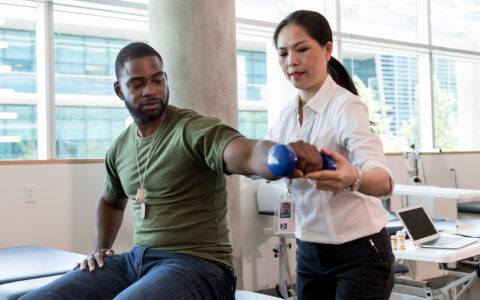Lower-back pain is the leading cause of disability worldwide, and neck pain the fourth. Patients are commonly prescribed a short-term anti-inflammatory treatment or guided muscle-strengthening exercises as first-line therapies, if no invasive intervention is warranted.
The coaching approach – Identify, Coordinate, and Enhance (ICE) – and standard individualized postural therapy (IPT) offer promising alternatives, but they are limited by broad practice variations and unclear efficacy.
To address these weaknesses, 33 centers across the country completed a four-year SPINE CARE trial that was powered and controlled to yield clear and actionable findings. A 2022 JAMA publication pitted the two methods against each other, as well as against a control group of variable primary care-directed measures.
Physical therapist Kristin R. Archer, Ph.D., director of the Center for Musculoskeletal Research at Vanderbilt University Medical Center, led the research at 12 centers within the Vanderbilt system.
“We found that outcomes from the two study interventions were about equal, and superior to those in the control group. Importantly, the coaching-based ICE model was less expensive than more standard IPT therapy, since fewer in-person and overall sessions are required,” Archer said.
Two Study Arms
Acute or subacute spine pain, like muscle spasms or sprains with no neurological injury, generally resolve within three months with or without home treatments, exercises or physical therapy, the researcher noted. In some individuals, however, acute pain develops into a chronic condition. Testing methods of avoiding this progression was the focus of the two SPINE CARE study arms.
The ICE model engages a multidisciplinary team that enables the patient to call the shots, choosing and committing to a plan that fits them individually. While this includes suggested exercises, other decisions like timing and number of repetitions are at the patient’s discretion. Health coaches or physical therapists may offer pain management techniques to deal with and avoid catastrophizing pain, including deep breathing or guided imagery.
“The coaching session is a bio-psycho-social intervention that promotes self-efficacy,” Archer said. “The idea is to work with the patient to help them take their own recovery seriously, set their own goals, and make realistic plans and commitments to themselves to do the work.”
“The idea is to work with the patient to help them, set their own goals, and make realistic plans and commitments.”
Patients in the ICE arm completed a brief screening tool, and were referred for 1-3 meetings with a coach and 1-3 physical therapy sessions, depending on the patient’s risk profile.
In contrast, IPT study arm participants received up to nine sessions of supervised exercise by a trained professional, either in-person or via video call, to improve spinal alignment and postural control.
“Self-efficacy is also encouraged in IPT,” Archer said. “But it is primarily based on more intense exercises, similar to Pilates over time, with the goal of stretching and strengthening the spinal tissue.”
Less is Sometimes More
Of the multicenter study participants, 829 were randomized to the ICE model, 1,150 to IPT intervention and 992 to PCP-led care involving ibuprofen, icing, and muscle relaxants.
Examining the Oswestry Disability Index score for changes at three months and spine-related health care spending at one year, the researchers found ICE and IPT patients’ scores fell by about half and were equivalent, while the control group scores only dropped by about a third.
Approximately 70 percent of patients on the ICE regimen and 67 percent of patients in IPT had a clinically significant reductions in their disability scores, compared to 58 percent in the primary-care control arm. At 12 months, patients in both interventional groups also had a lower rate of disability, and greater improvements in quality of life and self-efficacy.
At 12 months, mean spending for patients in the ICE group was $1,448, which was on par with the control group ($1,587) and much lower than the IPT arm ($2,528).
“While it can seem counterintuitive to address severe acute pain with only one to three interventional sessions, this study shows that more is not needed, that by using a valid screening tool and trained coaches, this brief number of sessions do just as well,” Archer said.
Dissemination Pathway
Archer cautions that it is challenging to deploy the ICE approach right away, first because of its novelty and second because health coaches are not typically part of orthopaedic care teams. Currently, patients opting for a health coach would have a referral involving out-of-pocket expenses.
“The first thing we can do to disseminate this model is embed the brief screening tool into the EHR so primary-care physicians can stratify patients for rehabilitation referral,” she said. “Then, of course, we need coaches at the other end of the referral. It is probably most cost-effective to hire physical therapists that have training in health coaching and motivational interviewing techniques. But, since this is still a small proportion of the staff, centers can sponsor training in this intervention.”





